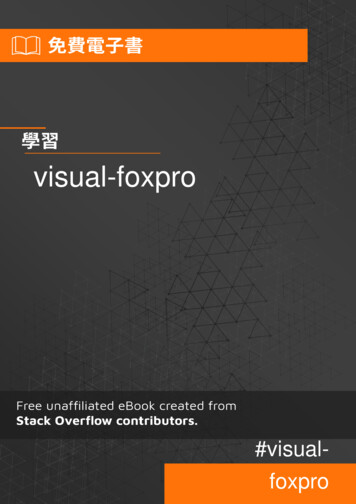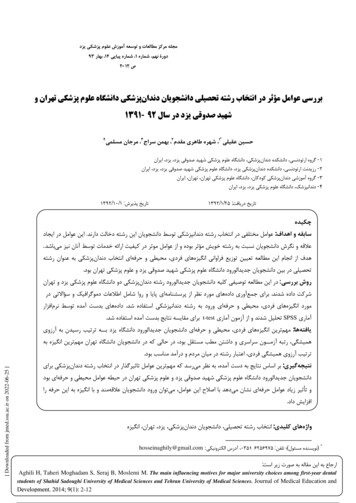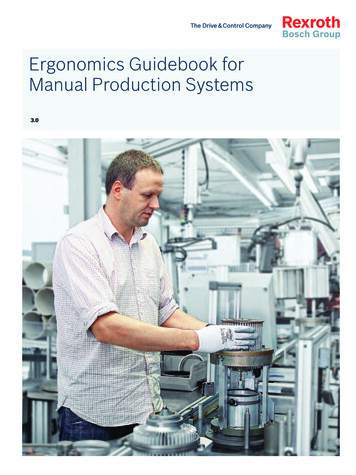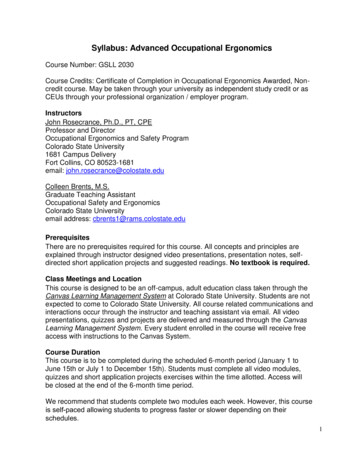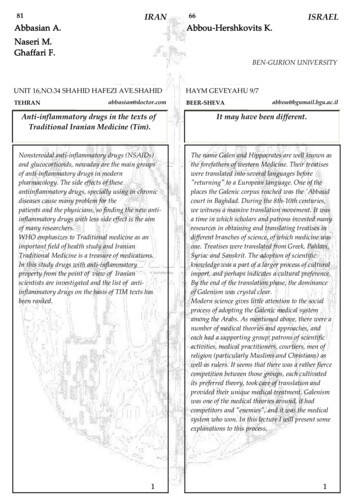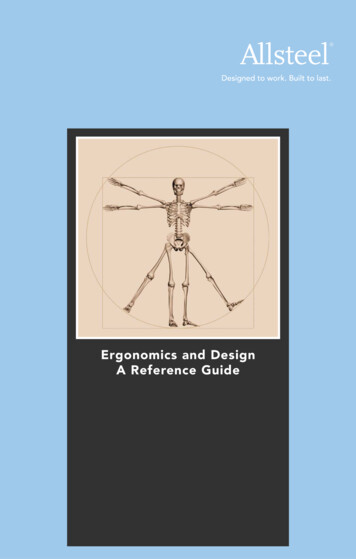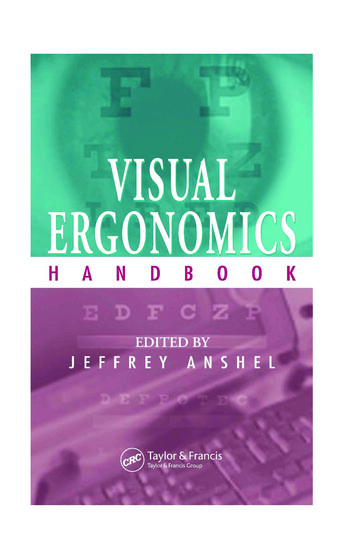
Transcription
VISUALERGONOMICSHANDBOOK
L1682 C000.fm Page ii Tuesday, May 17, 2005 10:15 AM
VISUALERGONOMICSHANDBOOEDITED BYJ E F F R E YA N S H E LBoca Raton London New York SingaporeA CRC title, part of the Taylor & Francis imprint, a member of theTaylor & Francis Group, the academic division of T&F Informa plc.K
L1682 C000.fm Page iv Tuesday, May 17, 2005 10:15 AMPublished in 2005 byCRC PressTaylor & Francis Group6000 Broken Sound Parkway NW, Suite 300Boca Raton, FL 33487-2742 2005 by Taylor & Francis Group, LLCCRC Press is an imprint of Taylor & Francis GroupNo claim to original U.S. Government worksPrinted in the United States of America on acid-free paper10 9 8 7 6 5 4 3 2 1International Standard Book Number-10: 1-56670-682-3 (Hardcover)International Standard Book Number-13: 978-1-56670-682-7 (Hardcover)Library of Congress Card Number 2005041779This book contains information obtained from authentic and highly regarded sources. Reprinted material isquoted with permission, and sources are indicated. A wide variety of references are listed. Reasonable effortshave been made to publish reliable data and information, but the author and the publisher cannot assumeresponsibility for the validity of all materials or for the consequences of their use.No part of this book may be reprinted, reproduced, transmitted, or utilized in any form by any electronic,mechanical, or other means, now known or hereafter invented, including photocopying, microfilming, andrecording, or in any information storage or retrieval system, without written permission from the publishers.For permission to photocopy or use material electronically from this work, please access www.copyright.com(http://www.copyright.com/) or contact the Copyright Clearance Center, Inc. (CCC) 222 Rosewood Drive,Danvers, MA 01923, 978-750-8400. CCC is a not-for-profit organization that provides licenses and registrationfor a variety of users. For organizations that have been granted a photocopy license by the CCC, a separatesystem of payment has been arranged.Trademark Notice: Product or corporate names may be trademarks or registered trademarks, and are used onlyfor identification and explanation without intent to infringe.Library of Congress Cataloging-in-Publication DataVisual ergonomics handbook / edited by Jeffrey Anshel.p. cm.ISBN 1-56670-682-3 (alk. paper)1. Vision--Handbooks, manuals, etc. 2. Vision disorders--Handbooks, manuals, etc. 3. Videodisplay terminals--Health aspects--Handbooks, manuals, etc. 4. Human-computer interaction-Handbooks, manuals, etc.RC965.V53V57 2005617.7--dc222005041779Visit the Taylor & Francis Web site athttp://www.taylorandfrancis.comTaylor & Francis Groupis the Academic Division of T&F Informa plc.and the CRC Press Web site athttp://www.crcpress.com
L1682 C000.fm Page v Tuesday, May 17, 2005 10:15 AMContentsPreface . viiIntroduction . xvii1. Windows to the World . 1Jeffrey Anshel2. The Eyes and Visual System . 5Jeffrey Anshel3. Electronic Visual Displays . 15Herb Berkwits4. Computer Vision Syndrome . 23Jeffrey Anshel5. Office Lighting for Computer Use . 37James E. SheedyAddendum: The Case for Anti-Glare Computer Filters . 53Sharon Middendorf6. General Ergonomics Principles . 63Carolyn M. Sommerich7. Vision Examinations and Glasses . 77Stephen Glasser8. Vision in Industrial Settings . 89Bernard R. Blais9. Kids and Computers . 137Alan Hedge10. General Eye Care Tips . 159Jeffrey Anshel
L1682 C000.fm Page vi Tuesday, May 17, 2005 10:15 AM11. Economics of Visual Ergonomics . 171Maurice Oxenburgh and Pepe MarlowAppendix AComputer Workplace Questionnaire .181Appendix BSeal of Acceptance Program for ComputerGlare Reduction Filters As of November 2004.183Appendix CResources for the Blind and VisuallyImpaired .185Appendix DComputer Access Products for Blind andVisually Impaired Users .197Appendix EAdditional Resources .205Glossary . 207Index . 213
L1682 C000.fm Page vii Tuesday, May 17, 2005 10:15 AMPrefaceIf you are reading this book clearly and comfortably, then congratulations— your eyes are probably working well. Yet it’s also most likely that youspend several hours per day staring at a computer screen (maybe even whilereading this book). Viewing an electronic display screen varies significantlyfrom reading text on paper and our eyes most often suffer for it. We needto address this problem and find out what can be done to make our computerviewing time more comfortable, as well as more productive.Both optometrists and ergonomists realize that the eyes are a critical partof proper ergonomics. It has been said that the eyes lead the body, so onecannot rightfully be considered without the other. However, ergonomistsoften have just a rudimentary understanding of the human visual system.This text combines the efforts of leading experts in the fields of optometry,ergonomics, eye safety, and occupational medicine. It integrates their knowledge into a comprehensive, easy-to-read volume that is sure to appeal to allinterested parties.The first chapters deal with the eyes and visual system. Chapter 1 startsoff with a historical perspective on how our vision and visual system aredesigned to work and how they have been challenged to keep up with oursocial development. Chapter 2 offers a simplified but thorough discussionof the process of eyesight and the components of the visual system. The levelof discussion is such that the health and safety professional will feel confidentin learning how the eyes work and why subsequent recommendations arejustified.Next comes a discussion of the technology behind computer displays.Because the images created on a monitor differ from standard ink-on-paper,the eyes adjust to the image differently. An explanation of the terminologyand image generation for the older cathode-ray tube (CRT) and the newerliquid crystal display (LCD) technologies are discussed.The next chapters discuss the environmental issues surrounding eye symptoms and vision in the workplace. It covers lighting, glare, monitor position,viewing distances, and other issues in detail.The American Optometric Association has defined computer vision syndrome (CVS) as “that complex of eye and vision problems related to nearwork that are experienced during or related to computer use.” A completediscussion of the signs and symptoms of this condition is detailed andreviewed.Following this is a discussion of lighting issues surrounding display usein the workplace. One of the major differences between viewing a displayscreen and viewing printed matter is that displays are self-illuminated,
L1682 C000.fm Page viii Tuesday, May 17, 2005 10:15 AMwhereas paper requires external illumination. We explore the details of thequality of light and how to properly light a workplace so that all areas areclear and comfortable. A section on glare in the workplace is also includedto clarify the role of anti-glare filters for displays.Because the visual system is integral with body posture, we also includea section on general ergonomic principles. We tie in these general ergonomicconcepts with the impact they have on the vision of computer users andshow how they depend on each other.The next chapter discusses how vision examinations differ for computerusers as opposed to more traditional examinations. This is meant to informthe health and safety professional as to what information is critical todescribe to the doctor. A discussion of “computer glasses” and how they areto be used in the workplace is included.In addition to computer use, the next chapter discusses eye safety inindustrial settings. This area not only covers safety glasses but also includesgovernment standards, types of equipment, visual considerations, contactlenses, and more.While not specifically involved with current office ergonomic considerations, the effect of computer use on children is also pertinent to this discussion. A recent survey indicates that about 80% of children from the agesof 8 to 18 use computers on a regular basis. In addition, software makersnow target their products for children as young as 18 months old! The futureworkforce is being created, and problems experienced while a young personwill often carry over to productivity and performance in the workplace.No discussion of ergonomics can be complete without including the economic impact of such programs in the workplace. Ergonomic considerationsare often limited by the economics of a particular company. The book concludes with a discussion of these closely related issues.The appendices include a computer vision questionnaire, an occupationalvision questionnaire, resources for blind and visually impaired employees,a seal-of-approval list for antiglare filters from the American OptometricAssociation, a list of ergonomic accessories from various companies, andadditional resources.This book is a compilation of contributions from some of the best mindsin the ergonomics community. While it is impossible to single out the bestin any field, I feel confident that these professionals have significant contributions to make in the area of visual ergonomics. Following the Introductionis a roster of the contributors and short biographies noting their accomplishments.
L1682 C000.fm Page ix Tuesday, May 17, 2005 10:15 AMThe EditorJeffrey R. Anshel, B.S., O.D.Dr. Jeffrey Anshel is a 1975 graduate of the Illinois College of Optometry.He served as a lieutenant in the U.S. Navy from 1975 to 1977 in San Diego,where he established the Navy's first vision therapy center. He has writtennumerous articles regarding nutritional influences on vision, stress factorsthat affect visual performance, and computer vision concerns.In 1990, Dr. Anshel published his first book titled Healthy Eyes, Better Vision,a layman’s reference book containing useful information and practical adviceregarding vision care. His second book, Visual Ergonomics in the Workplace,published by Taylor & Francis, offers scientific and practical informationabout the interaction between computers and the visual system. It is a comprehensive guide to the role of vision in the workplace. Smart Medicine ForYour Eyes, Dr. Anshel’s third book, is a resource of remedies using conventional, nutritional, and homeopathic eye treatments.Dr. Anshel is the principal of Corporate Vision Consulting, where headdresses the issues surrounding visual demands while working with computers. His work includes a course for eyecare professionals through whichhe educates doctors on computer vision syndrome and a course on dry eyesyndrome. He also offers corporations on-site consultations and seminarsrelated to visual stress in the workplace. Dr. Anshel is an assistant professorat the Southern California College of Optometry in Fullerton, California, andcurrently maintains a full-service practice in Carlsbad, California.
L1682 C000.fm Page x Tuesday, May 17, 2005 10:15 AM
L1682 C000.fm Page xi Tuesday, May 17, 2005 10:15 AMContributorsHerb Berkwits, M.E.E.For more than 30 years, Herb Berkwits has been involved in the design,marketing, and sales of all types and sizes of displays, from half-inch LCDsto huge stadium scoreboards. Originally hired as a display design engineerby Hughes Aircraft Company, he has more recently held management positions with leading display companies such as Mitsubishi and ViewSonic. Mr.Berkwits is currently the Senior Product Manager for Quest International, adistributor of high-performance LCD monitors for medical imaging. Mr.Berkwits holds a Bachelor’s and a Master’s Degree in Electrical Engineeringfrom Cornell University.James Sheedy, O.D., Ph.D.Dr. Sheedy is an associate professor of optometry at The Ohio State University College of Optometry. He previously served as a clinical professor atthe University of California at Berkeley School of Optometry, where hefounded the first VDT Eye Clinic in 1985. He is widely recognized as thepre-eminent scientific and clinical expert on vision issues in the workplace— especially among computer users. He has been a public spokesperson onmany eye-related issues, has appeared on several radio and television programs, and has been quoted in numerous publications including three timesin The Wall Street Journal (once on the front page).He is active in the American Optometric Association and the AmericanAcademy of Optometry, of which he is a fellow and a diplomate. He hasalso been active in the ophthalmic industry and has participated in thedevelopment of numerous standards and regulations, including ANSI, ISO,OSHA, and for state legislatures. He received the Distinguished ServiceAward from Prevent Blindness America for his work with ultraviolet protection and for coordinating the efforts of the American Optometric Association and the American Academy of Ophthalmology on this issue.Dr. Sheedy has performed research into various areas of visual performance and visual symptoms, and has been recognized with several researchawards, including twice receiving the Garland Clay Award for the bestclinical research published in the journal of the American Academy ofOptometry. He has also received the William Feinbloom Award from the
L1682 C000.fm Page xii Tuesday, May 17, 2005 10:15 AMAmerican Academy of Optometry for his contributions to vision care. Hehas more than 100 published articles and gives numerous lectures to bothprofessional and lay groups. Currently, he continues his research and clinicalwork at his OSU Vision Ergonomics Research Laboratory.Sharon M. MiddendorfSharon M. Middendorf, senior technical marketing specialist in 3M’s OpticalSystems Division, manages the division’s technical marketing, regulatory,and human factors applications and affiliations. She has degrees in historyand physics and serves as a corporation expert on visual ergonomics andthe computing environment. She served for five years on the InternationalStandards Organization (ISO) working group for electronic display ergonomics and chaired the subcommittee for the introduction and scope of anew electronic display measurement consolidation standard.Sharon has been a consultant for many different companies, including theNew York Metropolitan Opera, ErgoNorms Compliance Center, Cornell University Human Factors Laboratory, and TÜV Rheinland Product Service. Shehas presented on “Vision and the Computing Environment” to Wells FargoBank, La Opinion newspaper, and ergonomic assessment teams within 3M.In addition to being a consultant, she holds many professional memberships,including the International Association of Privacy Professionals, the HumanFactors and Ergonomics Society (HFES), the Computer Security Institute, theSociety for Information Display, and the Standards Engineering Society.Carolyn M. Sommerich, Ph.D.Dr. Sommerich is an associate professor in the Department of Industrial,Welding & Systems Engineering at The Ohio State University and holds anadjunct appointment in the Department of Industrial Engineering at NorthCarolina State University. Her research focus is ergonomics and occupationalbiomechanics, with special interests in the upper body, upper extremities,and office ergonomics. She has received funding for research addressingbiomechanical effects of computer monitor placement and keyboard designand use, and ergonomic aspects of portable computer use, as well as thestudy of risk factors for upper extremity musculoskeletal disorders in thefurniture manufacturing industry and in agricultural work. She is the authorof papers on a diverse range of ergonomics issues, including work-relatedmusculoskeletal disorders of the shoulder, assessment of carpal tunnel pressure during keyboarding, and changes in patterns of trunk muscle activityin response to lifting task requirements.
L1682 C000.fm Page xiii Tuesday, May 17, 2005 10:15 AMDr. Sommerich serves as a member of the editorial boards of the Journalof Electromyography and Kinesiology and International Journal of Industrial Ergonomics, and is an occasional reviewer for several peer-reviewed journals,including Human Factors, Applied Ergonomics, and American Journal of Industrial Medicine. She is the past chair of the Ergonomics Committee of theAmerican Industrial Hygiene Association and is currently serving theHuman Factors and Ergonomics Society as an at-large member of its Executive Council. She is also the faculty advisor to OSU’s student chapter ofHFES. She teaches courses at the graduate level in occupational biomechanics, upper extremity biomechanics, musculoskeletal mechanics, and usercentered design. She also teaches undergraduate courses in work analysisand design, ergonomics, and engineering economics. She graduated summacum laude from the University of Cincinnati, with a B.S.M.E., and earnedher M.S. and Ph.D. from The Ohio State University.Stephen L. Glasser, O.D., FAAODr. Glasser did his professional studies at the Pennsylvania College ofOptometry, after completing undergraduate studies at The Ohio State University. Having practiced in Washington, DC, since 1976, Dr. Glasser's expertise has been sought by both television and print media. In addition, he hasbeen recognized by his profession as practicing the highest standards ofexcellence — by being named as a fellow of the American Academy ofOptometry, by being named one of the nation's “Best and Brightest” in theeye care field by 20/20 Magazine, and by being named Optometrist of theYear by the Optometric Society of the District of Columbia for 1995.Dr. Glasser lectures regularly on and is a consultant in the field of computerergonomics. His presentations have taken him from Alaska to Florida, speaking to doctors, professional organizations, and office staffs alike. His consulting work has included work with law firms, media groups, governmentalagencies, and international corporations. Dr. Glasser is in private practice inWashington, D.C.Bernard R. Blais, M.D., FACOEM, FAAO, FACSDr. Blais is Clinical Professor of Ophthalmology at Albany Medical College,Albany, New York. He is co-chair of the ACOEM Sensory Perception Committee and serves on the Council on Scientific Affairs. He is board certifiedin ophthalmology.He served for 30 years as a commissioned officer in the United States Navy,during which time, approximately 20 years, he was trained and subsequently
L1682 C000.fm Page xiv Tuesday, May 17, 2005 10:15 AMtrainer, as chairman of two ophthalmology departments at Naval HospitalPhiladelphia and Naval Medical Center Bethesda, Maryland. In the subsequent 10 years, he was the Force Medical Officer of the Military SealiftCommand (corporate medical director), Head of the Surface/Sealift Operational Division at Bureau of Medicine and Surgery, U.S. Navy.From 1988 to 1996, he was Regional Medical Director, Lockheed-MartinCorporation (formerly General Electric Company) Knolls Atomic Power Laboratory (KAPL, Inc.), Schenectady, New York. This facility is a researchdevelopment and training laboratory operated by Lockheed-Martin as acontractor for the Department of Energy (DOE) and the U.S. Navy–NavalReactors Program. KAPL, Inc. has approximately 3,000 employees and 4,000active duty personnel. The Medical Director was responsible for three sitesat KAPL, Inc.: Knolls Site, Schenectady, New York; Kesselring Site, SaratogaSprings, New York; and Windsor Site in Windsor, Connecticut.As president of Blais Consulting Ltd. in Clifton Park, New York, since July1996, he is a consultant specializing in occupational ophthalmology. The goalis to organize and bring together information regarding eyes in the workplace. His combined years in ophthalmology and occupational medicine inthe Navy provided him with expertise in occupational safety, eye care in theworkplace, occupational visual standards, and visual ergonomics for theworkplace.Alan Hedge, Ph.D.Dr. Hedge is a professor in the Department of Design and EnvironmentalAnalysis, Cornell University, where, since 1987, he has directed the HumanFactors and Ergonomics teaching and research programs. Prior to that, formore than 10 years he ran the Graduate Program in Applied Psychology andErgonomics at Aston University, Birmingham, U.K. From 1990 to 1993, hewas also an Honorary Research Fellow at the Institute of Occupational Health,University of Birmingham, U.K. He is a fellow of the Human Factors andErgonomics Society, a fellow of the Ergonomics Society (UK) and a CertifiedProfessional Ergonomist. He received the 2003 Alexander J. Williams Jr.Design Award from the Human Factors and Ergonomics Society.His research and teaching activities have focused on issues of design andworkplace ergonomics as these affect the health, comfort, and productivityof workers. His research themes include workstation design and carpaltunnel syndrome risk factors for workers, alternative keyboard and inputsystem designs, the performance and health effects of postural strain, andthe health and comfort impacts of various environmental stressors, such asthe effects of indoor air quality on sick building syndrome complaints amongoffice workers, and the effects of office lighting on eyestrain problems amongcomputer workers. He has co-edited the Handbook of Human Factors and
L1682 C000.fm Page xv Tuesday, May 17, 2005 10:15 AMErgonomics Methods, co-authored Keeping Buildings Healthy: How to Monitorand Prevent Indoor Environmental Problems, and published 30 chapters andmore than 160 articles on these topics in the ergonomics and related journals.Maurice Oxenburgh, B.Sc., Ph.D., FESADr. Oxenburgh graduated from the University of New South Wales with adoctorate in biochemistry but, for the past quarter of a century, has workedin occupational health and safety, where his principal interests have been inoccupational hygiene and ergonomics. In March 2000, he gave evidence inWashington, D.C., to support OSHA’s proposed Ergonomics Standard.While working in industry, Dr. Oxenburgh realized that, although managers wanted efficient workplaces, they saw safety as a cost. His experienceshowed otherwise, and he has taken it as an article of faith that a safeworkplace is more effective, efficient, and productive than one that is not safe.Dr Oxenburgh is presently ensconced as Emeritus Research Scholar at theNational Institute for Working Life (Sweden), continuing his work on developing methods for measuring worker safety and productivity. He is a fellowof the Ergonomics Society of Australia.Pepe Marlow, B.App.Sc., M.Com., MHFESAPepe Marlow has worked for 20 years in occupational health and safetywhere her principal interest has been in ergonomics. Early on in her careershe experienced frustration in assisting workplaces to see the benefits ofergonomics and so went on to study economics, graduating from the University of New South Wales with a master’s degree in commerce.In 1997, Pepe prepared “Estimation of the regulatory impact of the nationalstandard for manual handling component of the proposed consolidated OHSregulation” for WorkCover NSW, Australia. She developed a cost-benefitanalysis of the impact of this standard based on available data and estimatesfor missing data.Since that time, she has worked extensively with Maurice Oxenburgh,writing several publications showing how to calculate the cost benefit ofoccupational health and safety, as well as presenting at conferences andrunning workshops on the same subject.Pepe is presently working as an occupational health and safety consultant,continuing her focus on assisting workplaces to see the benefits that comefrom improved ergonomics.
L1682 C000.fm Page xvi Tuesday, May 17, 2005 10:15 AM
L1682 C000.fm Page xvii Tuesday, May 17, 2005 10:15 AMIntroduction“Seeing is believing”“An eye for an eye”“In the blink of an eye”“I see what you mean”Many of our oldest and wisest sayings deal with the eyes. That’s probablybecause vision is our primary connection with the world. We use our eyesto interact with our environment in more than a million ways every second.The eyes really are an extension of the brain and a direct link between ourenvironment and our minds. More than 80% of our learning comes from ourvision, which indicates how important our sense of sight is in our daily lives.The process of vision begins with visible light — a portion of the radiationspectrum that stimulates the nerve endings in the retina. The eyes can senseabout 10 million gradations of light and about 7 million different shades ofcolor. The retina is about the size of a postage stamp and is made up of about130 million light-sensitive cells. It captures light and transforms it into nerveimpulses, and it can form, dissolve, and create a new image every tenth ofa second.The eyes are truly the windows to our world and to our soul. Because oftheir connection to the brain, they influence most of our cognitive thoughtprocesses. When the computer was first developed in the late 1940s, it wasmost often compared to the brain — with a network of interconnections anda sense of logical “thinking.” Even today, we tend to think that the computeris highly sophisticated and able to react as quickly and accurately as thehuman brain. And the way we primarily interact with the computer isthrough our eyes (the visual display).The connection between the visual display and the eye is a natural one.The computer generates and organizes information for our needs and displays that information on the screen. We then capture that information withour eyes. You might think of the eyes as the connection between the two“brains” we use. In order to maintain that link, our visual system mightmake certain adaptations to ease the flow of information. These adaptationscan often lead to other physical complications. Therefore, we should takecare of our eyes to ensure that our computer viewing habits, viewing environment, and visual condition are all considered wherever we use the computer.
L1682 C000.fm Page xviii Tuesday, May 17, 2005 10:15 AMUsing a computer is a twenty-first century necessity. The computer hassurpassed the telephone as the number one essential office tool. Yet onesignificant difference remains between the telephone and the computer, andit involves vision. While you don’t really have to see a telephone to use it,it’s a very different story when it comes to computer use.If you ask most people about their computer, they’ll actually be thinkingabout the monitor or visual display. The main interaction people have withtheir computers is through their eyes, and statistics demonstrate the effectsof this. A recent survey of computer users indicated that eyestrain is themain complaint of more than 80% of them. While carpal tunnel syndromehas become a common malady for many computer users, more people actually suffer from computer vision syndrome, or CVS. The American Optometric Association has designated CVS as the “complex of eye and visionproblems related to near work that are experienced during or related tocomputer use.” Much of the text herein is dedicated to defining and resolvingthis condition.Because computer use is so very different from viewing paper-based tasks,our eyes have to make an adjustment in the way we see. As adaptable aswe humans are, our eyes will most likely adapt to this new viewing situation,but not without the stress and strain that comes with a new viewing modality. It is the purpose of this book to review the research and concepts aboutvision as related to computer use, and to assist in making this new viewingsituation as comfortable as possible.It is hoped that this book serves as a cornerstone for a good understandingof the role vision plays in the lives of employees in the workplace. I havebrought together some of the most revered experts in their respective fieldsto offer the most recent research and quality information available.The efficiency with which we see relates directly to how efficiently andsafely we perform on the job. We spend almost one third of our lives workingand our eyes are the source of our most important sense. It is my hope thatthey work well throughout an entire lifetime.
1Windows to the WorldJeffrey AnshelCONTENTSOur Ancestral Eyes.1The Information Age .2An Eye on the Future.3The eyes are simple tools designed to catch light. However, the method bywhich they gather, filter and guide the light, as well as the way in whichour brains process the information received by the eyes, makes for thewonder of vision. In interacting with our environment, there is little tocompare with the contribution of the eyes. The way we use our eyes andvisual systems dictates how we
This text combines the efforts of leading experts in the fields of optometry, ergonomics, eye safety, and occupational medicine. It integrates their knowl-edge into a comprehensive, easy-to-read volume that is sure to appeal to all interested parties. The first chapters deal with the eyes and visual system. Chapter 1 starts

